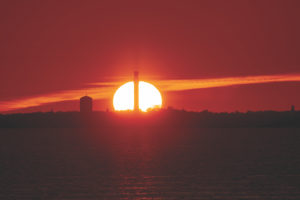
This month we reach the summer solstice. June 20 will be the longest day of the year and start of summer in the Northern Hemisphere. In the Southern Hemisphere, it’s the opposite — that same day being the shortest day of the year, and the start of winter. Our four seasons are not, as commonly thought, the result of Earth moving closer to or farther from the Sun over the course of the year (it does do that, but not enough to cause significant temperature changes). They are the result of Earth’s axis of rotation being tilted with respect to the plane of our orbit. That’s easy to write but difficult to visualize. Let’s dive in.
Earth is in constant motion. Some of that motion is familiar to everyone. Earth rotates like a spinning ball, causing night and day. It also orbits the Sun, like a runner around a racetrack; the time it takes to complete one orbit is what we call a year.
There’s more, maybe less familiar, motion to know about. The Sun orbits the center of our Milky Way galaxy, and where the Sun goes, so do we. Our galaxy is also in motion, currently “falling” towards the Great Attractor, a mysterious gravitational anomaly in intergalactic space. But to understand the four seasons, you need only to focus on the first two motions: Earth’s rotation and its solar orbit.
Picture that spinning ball, Earth. Next imagine a line running through the Earth from North to South Pole. That’s our axis of rotation. Take that spinning ball and start jogging around a circular track with it — you’re on our solar orbit. With me so far? Now things get interesting. Instead of holding that spinning ball perfectly upright, so that its axis of rotation is perpendicular to the racetrack, tip it slightly — 23.5 degrees from perpendicular, to be precise.
That tilt is what gives us our cycle of four seasons. Because the axis of rotation remains pointed at the same point in the sky, as we orbit the Sun the amount of direct sunlight that strikes the Northern and Southern Hemispheres varies over the course of a year. (Extra-credit question: our axis of rotation happens to point at a certain star. What star is it? The answer is below.) More direct sunlight means more energy. Things warm up. When the Northern Hemisphere is tipped towards the Sun, we call that spring and summer. But the warm weather doesn’t last forever. Earth continues its orbit. The Northern Hemisphere is now oriented away from the Sun. Less direct sunlight means less energy. Things cool down. Autumn, winter, repeat.
If our axial tilt were perfectly perpendicular to the plane of our orbit — no tilt — there would be no change of seasons. The Outer Cape would have no summer and no winter. The weather would always be something like early autumn or early spring. I don’t know about you, but I like the four distinct seasons, and am happy that Earth is slightly askew.
The extra-credit question? The answer is Polaris, also known as the North Star. But remember, everything is in motion. The stars in the night sky move, and so does Earth’s axial tilt. It wobbles like a spinning top, and right now it points at Polaris. Five thousand years ago the axis of rotation aligned with the faint star Thuban. In 4200 AD it will point close to the star Gamma Cephei. Nope, I had never heard of those stars either, until I looked them up for this column. Clear skies!



